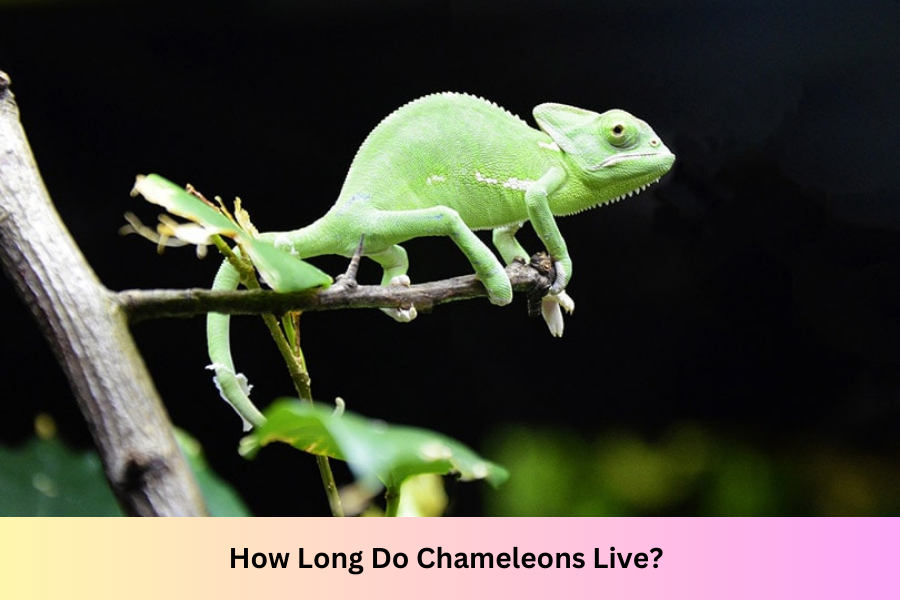Introduction
Chameleons are among the most fascinating reptiles in the world, known for their ability to change colors, their curious eyes, and their distinct slow movements. As a result, they often attract reptile enthusiasts and pet owners alike. If you’re considering adopting a chameleon, one of the most important questions you may have is, “How long do chameleons live?” The lifespan of these unique reptiles can vary significantly depending on their species, environment, and care. Let’s explore the factors that affect how long chameleons live and delve into the specific lifespans of different species.
Lifespan in the Wild
In the wild, chameleons face numerous dangers that can limit their lifespan. Predators, disease, habitat destruction, and other environmental stresses can all take a toll on their life expectancy. Most chameleons in the wild live between 2 to 5 years, with some species living even shorter lives.
One of the most significant factors affecting their lifespan in the wild is predation. Chameleons, despite their unique abilities, are not immune to natural threats. Larger animals, including birds, snakes, and mammals, often see chameleons as an easy meal. Because of their slow movement and relatively defenseless nature, chameleons are often unable to escape danger, shortening their lifespan.
Another factor influencing their life expectancy is disease. Wild chameleons are constantly exposed to bacteria, viruses, and parasites in their environment. Though they have natural defenses, these can sometimes be overwhelmed, especially if the chameleon’s immune system is weakened due to stress or malnutrition.
Lastly, environmental stressors such as habitat loss due to deforestation, climate change, and human development are becoming increasingly prevalent. As their natural environments shrink and change, chameleons often struggle to find food, water, and suitable shelter, further decreasing their chances of living a long life.
Lifespan in Captivity
In captivity, chameleons tend to live longer than they do in the wild, thanks to controlled environments and consistent care. When kept as pets, chameleons can often live between 5 to 10 years, though this varies by species. Captive chameleons are protected from natural predators and are provided with consistent food, hydration, and shelter, which can contribute to their longer lifespan.
That said, the longevity of a captive chameleon depends heavily on the level of care they receive. While some species may naturally live up to 10 years or more, improper care can reduce their lifespan. Factors like poor diet, inappropriate lighting, improper humidity levels, or stress can lead to health issues and shorten their life.
Proper husbandry practices are essential for maximizing the lifespan of chameleons in captivity. A chameleon’s environment needs to mimic its natural habitat as closely as possible. This includes maintaining the right temperature gradient (warm and cool zones), humidity levels, and providing UVB lighting to help them synthesize vitamin D3, which is necessary for calcium absorption. Failure to meet these needs can result in metabolic bone disease, poor growth, and a shorter lifespan.
Wiki
| Species Name | Lifespan in the Wild | Lifespan in Captivity | Key Characteristics |
| Veiled Chameleon | 2 to 4 years | 5 to 8 years | Known for its crest-like “veil” on the head, hardy, and popular among pet owners. |
| Panther Chameleon | 2 to 3 years | 5 to 7 years | Famous for its bright and vibrant colors, requires careful environmental control. |
| Jackson’s Chameleon | 3 to 5 years | 8 to 10 years | Characterized by three horns on its head, native to East Africa, needs cool temperatures. |
| Pygmy Chameleon | 1 to 2 years | 2 to 3 years | Smallest chameleon species, typically short lifespan, less commonly kept as pets. |
| Parson’s Chameleon | 8 to 10 years | 15 to 20 years | One of the largest species, known for its impressive size and long lifespan, but requires more space and care. |
| Meller’s Chameleon | 3 to 5 years | 6 to 8 years | Larger species, adaptable to various conditions but requires high humidity. |
| Oustalet’s Chameleon | 4 to 6 years | 6 to 10 years | Large species, found in Madagascar, needs a lot of space and high temperatures. |
| Veiled Chameleon | 2 to 4 years | 5 to 8 years | Characterized by a distinct “hood” on the head and a crest, commonly kept in captivity. |
| Tomato Frog Chameleon | 2 to 3 years | 4 to 5 years | Smaller species, named after its tomato-like color, requires a humid environment. |
| Ambilobe Panther Chameleon | 2 to 3 years | 5 to 7 years | Known for its stunning color patterns, more sensitive to temperature changes. |
Common Chameleon Species and Their Lifespan
Different species of chameleons have varying lifespans, and understanding these differences can help set expectations when adopting a chameleon. Here’s a look at some of the most popular species and their typical lifespans:
1. Veiled Chameleon (Chamaeleo calyptratus)
The Veiled Chameleon is one of the most popular species of chameleons kept as pets due to its striking appearance and manageable size. In the wild, Veiled Chameleons typically live around 2 to 4 years. However, in captivity, they can live 5 to 8 years with proper care.
These chameleons are hardy and can adapt well to captivity, making them a good choice for novice reptile owners. Their lifespan can be significantly extended with proper husbandry, especially by providing a varied diet and a suitable environment with appropriate UVB lighting.
2. Panther Chameleon (Furcifer pardalis)
Panther chameleons are known for their stunning colors, which vary from species to species. In the wild, their lifespan is around 2 to 3 years, though they can live longer in captivity with ideal care. In well-maintained enclosures, Panther Chameleons can live 5 to 7 years.
Because they are more sensitive to environmental conditions than some other species, their lifespan can be negatively impacted by improper humidity, temperature, and lighting. As a result, they are recommended for owners with more experience in chameleon care.
3. Jackson’s Chameleon (Trioceros jacksonii)
Jackson’s Chameleons, also known as “three-horned chameleons,” are native to East Africa and can live much longer than many other species. In the wild, their lifespan is typically 3 to 5 years, but in captivity, they can live as long as 8 to 10 years.
These chameleons are a bit more tolerant of cooler temperatures and are often easier to care for in a well-maintained vivarium. They require a steady diet of insects and a high humidity level to thrive in captivity, making them a great option for chameleon enthusiasts.
4. Pygmy Chameleon (Rhampholeon spp.)
Pygmy chameleons are among the smallest species of chameleons, and as their size suggests, they have a relatively short lifespan. In the wild, they live around 1 to 2 years, and in captivity, they may reach up to 2 to 3 years.
Due to their small size and specific habitat requirements, Pygmy Chameleons are less commonly kept as pets, but they can still thrive in a properly set-up terrarium. Their short lifespan makes them less of a long-term commitment compared to other species.
5. Parson’s Chameleon (Chamaeleo parsonii)
The Parson’s Chameleon is one of the largest chameleon species, and it also enjoys one of the longest lifespans among chameleons. In the wild, these chameleons can live up to 8 to 10 years. In captivity, with optimal care, they can live as long as 20 years.
Though Parson’s Chameleons are less common in the pet trade due to their size and specialized care needs, they are a fascinating species that can thrive with proper environmental conditions and care. Their long lifespan makes them a significant commitment for any potential pet owner.
Factors Affecting Chameleon Lifespan
Several factors impact How Long Do Chameleons Live, and providing the right environment and care is crucial for maximizing their lifespan.
1. Diet
The diet is one of the most important factors in ensuring the health and longevity of a chameleon. In the wild, chameleons eat a variety of insects, including crickets, locusts, and beetles. A healthy diet in captivity should include gut-loaded insects (insects that have been fed a nutritious diet) and a mix of vitamin and mineral supplements to prevent deficiencies.
If a chameleon does not receive a balanced diet, it can suffer from malnutrition, leading to weakened immune systems, stunted growth, and other health problems that reduce lifespan.
2. Environmental Conditions
Chameleons are sensitive to changes in temperature, humidity, and lighting. They need a controlled environment to thrive, with both a warm area and a cooler area in their enclosure to allow for thermoregulation. Humidity levels must also be carefully maintained, as dehydration can lead to serious health issues.
UVB lighting is crucial for vitamin D3 synthesis and calcium absorption. Without proper UVB exposure, chameleons can develop metabolic bone disease, which can lead to a shorter lifespan.
3. Stress Levels
Chameleons are solitary animals that prefer minimal interaction with humans or other animals. Constant handling or being housed in a stressful environment can weaken their immune system, making them more susceptible to illness and shortening their lifespan.
4. Genetics
As with any animal, genetics play a role in a chameleon’s lifespan. Some individuals may naturally have longer or shorter lifespans depending on their genetic makeup. However, the quality of care can also influence how long they live, sometimes compensating for genetic factors.
Health Care and Lifespan
To extend the lifespan of a chameleon, owners must be vigilant about their health. Regular vet check-ups, especially with a reptile specialist, can help identify and treat any illnesses early. Monitoring for signs of stress, disease, or malnutrition is vital, as chameleons often mask their symptoms until they are quite sick.
Additionally, preventing overcrowding and ensuring that each chameleon has enough space to roam and thrive will help reduce stress and promote a healthier, longer life.
Conclusion
In conclusion, the lifespan of a chameleon can vary significantly based on several factors, including its species, living conditions, and the care it receives. While wild chameleons typically live only 2 to 5 years due to predation, disease, and environmental stresses, chameleons kept in captivity can live much longer — anywhere from 5 to 10 years, or even longer, with proper care. Species such as the Veiled Chameleon and Panther Chameleon often live between 5 and 7 years in captivity, while larger species like the Parson’s Chameleon can live up to 20 years.
To ensure a chameleon lives a long, healthy life, it is crucial to provide them with a suitable environment, a balanced diet, proper humidity and lighting, and minimal stress. By mimicking their natural habitat and staying on top of their health needs, you can maximize their lifespan and enjoy the company of these fascinating creatures for many years.
FAQs
1. What is the average lifespan of a chameleon in captivity?
The average lifespan of a chameleon in captivity ranges from 5 to 10 years, depending on the species and the care provided. Some species, like the Veiled Chameleon, may live closer to 5-7 years, while others, like the Parson’s Chameleon, can live up to 20 years with the right care.
2. How long do Veiled Chameleons live?
Veiled Chameleons typically live between 5 and 8 years in captivity. In the wild, they may have a shorter lifespan due to natural threats, but with proper care in a controlled environment, they can live longer.
3. Can chameleons live longer in captivity?
Yes, chameleons can live longer in captivity compared to the wild due to the controlled environment that protects them from predators and ensures regular access to food and water. Proper care, such as a balanced diet, UVB lighting, and correct humidity levels, is essential to extending their lifespan.
4. What is the lifespan of a Panther Chameleon?
Panther Chameleons typically live for 5 to 7 years in captivity. However, their lifespan can be shortened by improper care, such as inadequate lighting or poor diet. In the wild, their lifespan is usually shorter, around 2 to 3 years.
5. How can I make my chameleon live longer?
To help your chameleon live a longer, healthier life, ensure that you provide the right environmental conditions. This includes maintaining proper temperature gradients, humidity, and UVB lighting. A balanced diet with gut-loaded insects and vitamin/mineral supplements is also crucial. Minimize stress by avoiding excessive handling and providing a spacious, safe habitat.
6. Why do chameleons have such a short lifespan in the wild?
In the wild, chameleons face constant threats from predators, disease, and environmental changes. Their natural life expectancy is often shortened by these factors, as well as the difficulty in finding food and suitable shelter. These challenges make it difficult for them to live as long as those in captivity.
7. Do chameleons require any special medical care?
Yes, chameleons require special medical care to maintain their health. Regular check-ups with a reptile veterinarian are important to catch any potential health issues early. Common health concerns in chameleons include metabolic bone disease, respiratory infections, and parasites. Proper husbandry practices can help prevent these issues.
8. How long do chameleons live in the wild?
In the wild, chameleons generally live between 2 to 5 years. Their lifespan is heavily influenced by factors like predation, disease, and environmental conditions, which are more challenging compared to living in captivity.
Explore the latest news and updates on Play Hop



